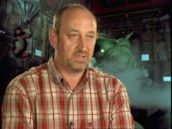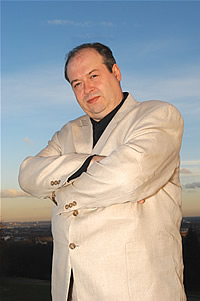Welcome aboard the Space Corps Jupiter Mining Vessel, the Red Dwarf.
"When Doug and I wrote together, we sat down at a table, I typed, and we agreed every word before it went down. People would come up to us and say: 'Ooh, that's a Rob line, isn't it?' or 'I bet Doug wrote that,' and Doug and I would look at each other a little baffled. That stuff about our being a gestalt was only a half joke."
- Rob Grant, interview with RedDwarf.co.uk
Red Dwarf was a cultural phenomenon. Following in the footsteps of other science fiction TV shows like Doctor Who, Red Dwarf was a show that had a lot to prove. Britain was being exposed greatly to the science fiction genre during the 1980's, and the people wanted more. Red Dwarf was a British science fiction sitcom based in the far reaches of deep space. This convenient setting allowed for a number of interesting stories in each new adventure. The people threw their support behind Red Dwarf early on, and the BBC had found a new star.
 Early History- Red Dwarf was the product of the combined minds of Rob Grant and Doug Naylor (the latter pictured at left), two gentlemen who worked together in college in Liverpool, England. The two started working at a popular radio program in London called Radio 4, doing radio sketch shows for the show Cliche and Son of Cliche. One of their sketches for these shows was called "Dave Hollins- Space Cadet" which featured Dave Hollins as the last man alive in the universe with his only companion being his ship's computer Hab ,"a not-very-subtle spoof on 2001's Hal" (Howarth and Lyons, 3). This show is what eventually lead to the idea of Red Dwarf.
Early History- Red Dwarf was the product of the combined minds of Rob Grant and Doug Naylor (the latter pictured at left), two gentlemen who worked together in college in Liverpool, England. The two started working at a popular radio program in London called Radio 4, doing radio sketch shows for the show Cliche and Son of Cliche. One of their sketches for these shows was called "Dave Hollins- Space Cadet" which featured Dave Hollins as the last man alive in the universe with his only companion being his ship's computer Hab ,"a not-very-subtle spoof on 2001's Hal" (Howarth and Lyons, 3). This show is what eventually lead to the idea of Red Dwarf.
After leaving Radio 4, Grant and Naylor wrote for other popular British shows, but they had one long-term goal: "a television sitcom to call their own" (Howarth and Lyons, 3). Eventually, the two sat down and began fleshing out a pilot script to submit to the producers at BBC. They decided to expand on the cast of characters to allow for more situations to arise, as well as to make the characters nonhuman lifeforms. The pilot script was finished in 1983 and was submitted to producers John Lloyd and Paul Jackson. Both loved the script, and Paul Jackson took over the production. He eventually convinced BBC (after three years of waiting) to make a series of six episodes in 1986.
Next, the writers and producers had to find a cast. Even though Grant and Naylor had anticipated using legitimate, well-established actors, "What they eventually got- and in fact selected themselves- was a poet, an impressionist, a dancer and a stand-up comic." (Howarth and Lyons, 5) An interesting side note is that the actor who plays Rimmer (Chris Barrie) was actually heavily considered for the role of Lister.
Production- Red Dwarf got off to a good start. Series one was considered a success by BBC executives. By the time series two rolled around, however, Red Dwarf had lost an estimated two million viewers (Howarth and Lyons, 73). The BBC continued to make episodes in spite of this daunting fact. Audience approval ratings were high and the production team had received many letters congratulating and praising the show.
Series three brought a number of changes to the show's appearance. Grant and Naylor took the proverbial driver's seat and started making changes to their vision. First of all, they hired Mel Bibby as set designer. The original sets were cheap and were made in various shades of grey, which didn't appeal greatly to the producers. Grant and Naylor hoped that Bibby would be able "to bring a fresh look that lifted Red Dwarf to new heights." (Red Dwarf: Series III) Additionally, Grant and Naylor hired Howard Burden as the new costume designer, who did a complete overhaul of each character's wardbrobe; Rimmer donned a new green spacesuit with a futuristic metallic sheen, and Lister wore an old motorcycle jacket adorned with various patches and curry stains. These new staff members radically changed the appearance of the show for the remainder of its runtime.
Things remained the same until around Series V, when Grant and Naylor decided to change the tone of show. The two wanted to make the show a little more meaningful, and, starting in Series V, "the balance between comedy and science fiction was tipped somewhat towards the latter." (Howarth and Lyons, 116) Series V saw the introduction of a more broad range of science fiction topics, from an entire ship crewed by hologramatic crew members ("Holoship") to the creation of two alternate Red Dwarf vessels, with one being populated by a completely benevolent crew and the other being populated by a crew of hellish filth-mongers ("Angels and Demons"). The show tried to become a more scientifically interesting show, all while maintaining its humorous touch.

Again, things remained stable for Red Dwarf until two series later in Series VII. A three-year gap separated Series VI from Series VII, and a lot had happened during that time. The most important event that occurred was that Rob Grant (see picture) and Doug Naylor ended their long-time partnership. Grant decided to pursue other projects and ended up working on several other projects as a writer, including two short-lived series named Dark Ages and The Strangerers (Rob Grant). Without Grant, Naylor had to fill both his and his ex-partner's shoes. Naylor made his best attempts to do just that by the reintroduction of old characters, including Lister's love interest Kristine Kochanski.
Other changes were made in Series VII also. Ed Bye, who had worked on Red Dwarf before as a director, returned to the show after hearing that Grant had left. Also, new writers were hired on to help Naylor move the show in a fresh direction. Finally, BBC made a few changes to the production of Red Dwarf, including not filming in front of a live audience and increasing the amount of special computer-generated effects. This gave "The seventh series of Red Dwarf a look distinctively different from that of its forerunners." (Howarth and Lyons, 149). However, by Series VIII, BBC had decided that it would no longer be airing Red Dwarf and that Series VIII would be the final season. The series ended with a grand total of fifty-two episodes.
Red Dwarf was not dead, however. Ten years after the end of the show, a new TV miniseries was released, entitled Red Dwarf: Back to Earth, wherein the Dwarfers find out that they were fictional characters on a television show. All members of the original cast returned to reprise their respective roles. According to www.redwarf.co.uk, the "official Red Dwarf website", the first episode drew in about four million viewers, with numbers dropping to near two million at the third and final episode. Reviews from critics were mixed.
Now, the fate of Red Dwarf is up in the air. Rob Grant did not assist Doug Naylor in writing the miniseries Back to Earth, and it is doubtful that a renewal of the series would interest Grant. For now, the series is best thought of by most as a memory and as one of the most memorable shows in science fiction history.
* * *
Last update: 11/23/2009
This site was created by Stephen Shapiro for HONR101, Speculative Visions, an honors course at DePauw University in Greencastle, Indiana, instructed by Dr. Arthur Evans. If you have any questions or comments about the website, please contact: stephenshapiro_2013@depauw.edu
 Early History- Red Dwarf was the product of the combined minds of Rob Grant and Doug Naylor (the latter pictured at left), two gentlemen who worked together in college in Liverpool, England. The two started working at a popular radio program in London called Radio 4, doing radio sketch shows for the show Cliche and Son of Cliche. One of their sketches for these shows was called "Dave Hollins- Space Cadet" which featured Dave Hollins as the last man alive in the universe with his only companion being his ship's computer Hab ,"a not-very-subtle spoof on 2001's Hal" (Howarth and Lyons, 3). This show is what eventually lead to the idea of Red Dwarf.
Early History- Red Dwarf was the product of the combined minds of Rob Grant and Doug Naylor (the latter pictured at left), two gentlemen who worked together in college in Liverpool, England. The two started working at a popular radio program in London called Radio 4, doing radio sketch shows for the show Cliche and Son of Cliche. One of their sketches for these shows was called "Dave Hollins- Space Cadet" which featured Dave Hollins as the last man alive in the universe with his only companion being his ship's computer Hab ,"a not-very-subtle spoof on 2001's Hal" (Howarth and Lyons, 3). This show is what eventually lead to the idea of Red Dwarf.